|
|
 |
|
Calanoida ( Order ) |
|
|
|
Diaptomoidea ( Superfamily ) |
|
|
|
Pseudodiaptomidae ( Family ) |
|
|
|
Pseudodiaptomus ( Genus ) |
|
|
| |
Pseudodiaptomus yamato Ueda & Sakachi, 2019 (F,M) | |
| | | | | | | Syn.: | Pseudodiaptomus inopinus : Sakaguchi & Ueda, 2010 (fig.7G); 2011 (p.124, as ''Pacific group'', fig. 2B, D, F, H, J); Soh & al., 2012 (p.233, fig.3B); Sakaguchi & Ueda, 2018 (p.173, as ''LP-form'', fig.F, M) | | | | Ref.: | | | Ueda & Sakaguchi, 2019 (p.29, Descr. F, M, figs.F, M, Rem.) | 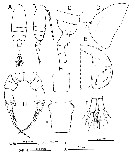 Issued from : H. Ueda & S.O. Sakaguchi in Plankton Benthos Res., 2019, 14 (1). [p.32, Fig.1, A-F, H, I, U]. Female (from CVhikugo River): A-B, habitus (dorsal and lateral, respectively); C, 3rd prosome to 4th urosomite; D, last pediger (lateral); E, right half of last pediger, posterior (view from indicated with a white arrow in D); F, genital double-somite (dorsal); H, 2nd urosomite with dorsal spinules; I, caudal rami (dorsal); U, P5 (posterior). Nota: - 2nd and 3rd pedigers with row of fine spinules along posterolateral margin. - Lastb pediger on each side, with spiniform small dorsal attenuation, weakly protruding posterior projection, and 3 groups of spinules in rows, i.e., row of slightly curved, long spinules on dfistolateralmcorner (indicated by arrow with 'a' in fig. 1E), irregular rows of medium and fine spinules on distomedial surface (indicated by arrow with 'b'), and long transverse row of fine spinules on lateral surface (indicated by arrow with 'c'). - Genital double-somite with 2-4 fine spinules on anterolateral projection, 2 groups of a few fine dorsolateral spinules at about 1/3 and 4/5 length of somite, respectively, and fine lateral setule at mid length on each side. - Dorsal surface of 2nd free urosomite with transverse row of 2-5 fine spinules at about 3/5 length on each side. - Caudal rami length around 2.4 times width.
|
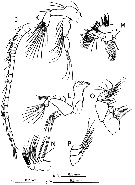 Issued from : H. Ueda & S.O. Sakaguchi in Plankton Benthos Res., 2019, 14 (1). [p.32, Fig.1, J,-P]. Female: J, left A1; K, A2; L, Md; M, Mx1; N, Mx2; O, Mxp; P, 2nd to 4th endopodal segments of Mxp.
|
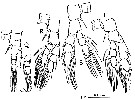 Issued from : H. Ueda & S.O. Sakaguchi in Plankton Benthos Res., 2019, 14 (1). [p.32, Fig.1, Q-T]. Female; Q, left P1 (anterior); R, right P2 (posterior); S, left P3 (posterior); T, right P4 (posterior).
|
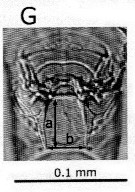 Issued from : H. Ueda & S.O. Sakaguchi in Plankton Benthos Res., 2019, 14 (1). [p.32, Fig.1, G]. Female: G, photograph of genital operculum (ventral view). Nota: Genital operculum with long posterior processes; process longer than distance between tips ('a' > 'b')
|
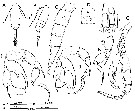 Issued from : H. Ueda & S.O. Sakaguchi in Plankton Benthos Res., 2019, 14 (1). [p.33, Fig.2, A-D, F-K]. Male (from Chikugo River): A-B, habitus (dorsal and lateral, respectively); C, urosome (lateral); D, 2nd urosomite (ventral); F, caudal rami (dorsal); G, right A1 (ventral)); H, 19th to 215t segments of right A1 (dorsal); I, P5 with paddle-shaped right terminal segment (posterior); J, P5 with finger-shapede rightb terminal segment (posterior); K, right leg of J (viewed from different angle).
|
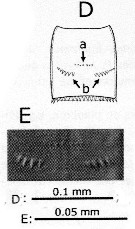 Issued from : H. Ueda & S.O. Sakaguchi in Plankton Benthos Res., 2019, 14 (1). [p.33, Fig.2, D, E]. Male: D, seconf urosomite (ventral); E, photograph of spinular rows in D.
| | | | | Compl. Ref.: | | | Ueda & al., 2004 (p.630, fig.4. , as P. inopinus, distribution vs stations ); Ueda & al., 2010 (p.1559, Fig.1, 11, as P. inopinus abundance and S. tenellus vs depths); Suzuki & al., 2012 (p.1049, fig.4, life-cycle); Suzuki & al., 2013, fig.6, as P. inopinus, abundance vs salinity & T°C, turbidity, ). | | | | NZ: | 1 | | |
|
Distribution map of Pseudodiaptomus yamato by geographical zones
|
| | | 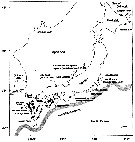 Issued from : H. Ueda & S.O. Sakaguchi in Olankton Benthos Res., 2019, 14 (1). [37, Fig.5]. Issued from : H. Ueda & S.O. Sakaguchi in Olankton Benthos Res., 2019, 14 (1). [37, Fig.5].
Locations from which Pdeudodiaptomus yamato (black circle) and P. japonicus (black triangle) have been recorded, with the location names appearing in the text.
Broken lines represent boundaries between their ranges.
The references are Sakaguchi & Ueda (2010, 2011) and the present study; the other five references are presented in parentheses.
Grey arrow represents the general patch of the Kuroshio Current replicated from Wikipedia (2018: Kuroshio Current) |
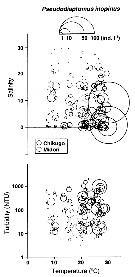 Issued from : K.W. Suzuki, K. Nakayama & M. Tanaka in J. Oceanogr., 2011, 69. [p.24, Fig.6]. As Pseudodiaptomus inopinus. Issued from : K.W. Suzuki, K. Nakayama & M. Tanaka in J. Oceanogr., 2011, 69. [p.24, Fig.6]. As Pseudodiaptomus inopinus.
Bubble plots of densities of the non semi-endemic oligohaline calanoid Pseudodiaptomus inopinus in relation to temperature, salinity, and turbidity observed in the Chikugo and Midori River estuaries (south Japan) in 2005 and 2006. |
| | | | Loc: | | | Japan (Chikugo, Manose, Kodono, Tama Rivers and a pond in Mie, S, E Honshu, Kyushu) | | | | Lg.: | | | (1235) F: 1,23-1,67; M: 1,10-1,30); {F: 1,23-1,67; M: 1,10-1,30} | | | | Rem.: | For UIeda & Sakaguchi (2019, p.29) this new species is endemic to Japan and confined to the coasts affected by the warm Kuroshio Current from western Kyushu to the middle of Honshu, while P. japonicus is widespread in northern East Asia without overlapping the range of P. yamato. The range of P. inopinusP. yamato and P. japonidcus.
The name yamato is the ancient name of Japan during the Kofun period between the 3rd and 6th centuries, this species being very close from japonicus | | | Last update : 05/09/2019 | |
|
|
 Any use of this site for a publication will be mentioned with the following reference : Any use of this site for a publication will be mentioned with the following reference :
Razouls C., Desreumaux N., Kouwenberg J. and de Bovée F., 2005-2025. - Biodiversity of Marine Planktonic Copepods (morphology, geographical distribution and biological data). Sorbonne University, CNRS. Available at http://copepodes.obs-banyuls.fr/en [Accessed December 25, 2025] © copyright 2005-2025 Sorbonne University, CNRS
|
|
 |
 |











